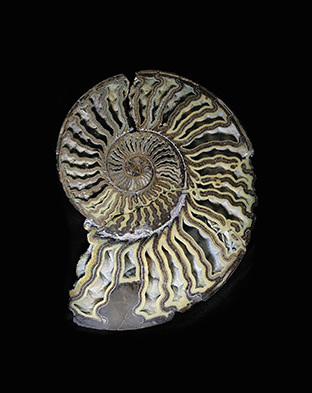 loading
loading
Arts & CultureTime travelObject lesson: "The most dangerous sea of all time." Susan H. Butts and Christopher A. Norris are senior collections managers at the Yale Peabody Museum.  Yale Peabody Museum, Division of Invertebrate PaleontologyThis ammonite fossil, sliced in half to reveal its interior, is one of tens of thousands of fossils the Yale Peabody Museum has had digitally scanned. They will be part of a public database that will help scientists to study both the past and the future. View full imageNearly 70 million years ago, the world was a very different place. Tyrannosaurus rex roamed a planet that had known a warm, stable greenhouse climate for tens of millions of years. There were no polar icecaps. Sea levels were hundreds of feet higher than they are today. To a visitor observing from space, one of the most dramatic features would have been a shallow sea covering most of interior North America. It had formed over the preceding 30 million years as the Earth’s crust buckled with tectonic activity. At its maximum extent, what we now call the Western Interior Seaway was roughly the same size as the Mediterranean. It has been called the most dangerous sea of all time. In its waters swam sharks, turtles as big as small cars, rapacious fish 20 feet long, and the colossal predatory reptiles known as mosasaurs. In addition to these sea monsters, the Seaway supported a multitude of smaller species—plankton, shellfish, arthropods, and echinoderms, as well as the pterosaurs and toothed seabirds that soared and dived in the air above. Among the shellfish was the creature whose fossilized shell is shown here: an ammonoid, a relative of today’s nautilus, squid, and octopus. Ammonoids were among the most abundant animals in the Seaway. This one is a Placenticeras whitfieldi—to be exact, the Placenticeras whitfieldi labeled YPM IP 224090. Its coiled shell has been cut in half to reveal its chambers. The chambers started out small, but successively larger ones formed, in a spiral, to accommodate the growing creature. The largest, outermost chamber housed the shell’s tentacled inhabitant. All the chambers were connected by a permeable cord through which the occupant could pump water or air to fill them; this arrangement allowed the ammonoid to regulate its buoyancy. Ammonoid species, along with most of the fossil species found in the Western Interior Seaway, are well-studied, well-known creatures. But the Peabody is in the midst of a project that, when complete, will enable researchers to glean a new trove of information from fossils like this one. Along with eight other institutions, we’re creating a public digital database of life in the Seaway during the Cretaceous. The Peabody has one of the world’s most comprehensive Seaway fossil collections; less than two years into the three-year project, we’ve digitized nearly 70,000 fossils. The database will include not only images of each fossil but also, importantly, map coordinates. If you go to CretaceousWorld.org and search for YPM IP 224090, you’ll find the catalog entry for this particular fossil, including the rock formation in which it was embedded—the Pierre Shale of South Dakota. You’ll also see its original locality, at Sage Creek east of the Black Hills, marked on a scalable map. Information like this will enable scientists to ascertain when the various creatures of the Seaway lived and where, and how they evolved over time. What can we learn from the fossil ecology of a long-gone waterway? Although the climate of the Late Cretaceous was stable, the Seaway was not static. Drops in sea level sometimes cut it off completely from the open ocean, and rising sea levels would later reestablish the connection, allowing new species to invade and alter the ecosystems. Therefore, studying invasive species and changing sea levels in the Seaway could help us prepare for the very similar events that climate change will bring. YPM IP 224090 may play a tiny part in a much larger investigation to clarify our future.
The comment period has expired.
|
|